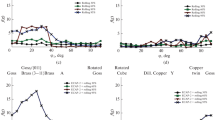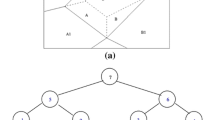Abstract
Slip and twinning systems activated by rolling in sequential passes were observed on a coarse grained zirconium polycrystal. At least five independent deformation modes are activated; slip and twinning systems occur simultaneously. For low degrees of deforma-tion the main slip system is prism slip\(\{ 10\bar 10\} \left\langle {12\bar 10} \right\rangle \), even when the orientation is not favorable. The lattice rotations caused by slip proceed gradually with increasing defor-mation; they are relatively small although the strain achieved can be large. On the other hand, twinning causes spontaneous, large-scale lattice rotations, even for low degrees of deformation. The type of twinning depends largely on the crystallographic orientation of the matrix. For basal pole orientations of the undeformed grains in the area 0 to 50 deg from the normal direction\(\{ 11\bar 22\} \) twinning becomes preferentially operative. For basal pole orientations of the undeformed grains in the area 50 to 90 deg from the normal direction, however,\(\{ 10\bar 12\} \) twinning becomes preferentially operative. In both orientation areas as a complementary system\(\{ 11\bar 21\} \) twinning is operative. For all deformation sys-tems their operation is independent of the azimutal position of the basal pole in these areas. The lattice rotations alter the orientation of the crystallites in such a way that the basal poles all become aligned more or less in the direction of the deforming compres-sive force. For higher degrees of deformation pyramidal slip with a (c + a) type Burgers Vector can explain why this preferred orientation is maintained as final position, which for zirconium shows a split of basal poles of ±30 to 50 deg towards the transverse direc-tion. The method of following the complicated interactions between different slip and twinning systems in a stepwise deformed, coarse grained sheet by 1) trace analysis of the deformation modes, 2) by correspondingly derived lattice rotations, and 3) by texture measurements leads to an explanation of the texture development in zirconium. It is dis-cussed on the basis of basal pole rotations.
Similar content being viewed by others
References
R. von Mises:Z. angew. Math. und Mech., 1928, vol. 8, pp. 161–85.
G. J.Taylor:J Inst. Metals, 1938, vol. 62, pp. 307–24.
J. F. W. Bishop and R. Hill:Phil. Mag., 1951, vol. 42, pp. 414–27 and 1298–1307.
G. Y. Chin, W. L. Mammel, and M. T. Dolan:Trans. TMS-AIME, 1967, vol. 239,pp.1854–55.
H. J. Bunge:Kristall Technik, 1970, vol. 5, pp. 145–75.
H. Siemes:Z. Metallkund., 1967, vol. 58, pp. 228–30.
P. G. Partridge:Met. Rev., 1967, vol. 12, no. 118, pp. 169–94.
M. L. Picklesimer:Electrochem. Technol., 1966, vol. 4, pp. 289–300.
R. E. Reed-Hill:Reviews on High Temperature Materials, vol. 1, pp. 97–155, Tel Aviv, 1972.
R. E. Reed-Hill, J. P. Rosi, and H. C. Rogers:Deformation Twinning, vol. 25, Gordon and Breach Science Publishers, New York, London, 1964.
J. W. Christian:Theory of Transformation in Metals and Alloys, Pergamon Press, Oxford, 1965.
E. Tenckhoff:Operable Deformation Systems and Mechanical Behavior of Textured Zircaloy Tubing, pp. 179–200, ASTM, STP 551, 1974.
E. A. Calnan and C. J. B. Clews:Phil. Mag., 1950–51, vols. 41–43, pp. 1085–1100, 616–35, and 919–31.
D. N.Williams and D.S. Eppelsheimer:J. Inst. Metals, 1952–53, vol. 81, pp. 553–62.
D.N.Williams and D. S. Eppelsheimer:Nature, 1952, vol. 170, pp. 146–47.
D. O. Hobson:Trans. TMS-AIME, 1968, vol. 242, pp. 1105–10.
D. O. Hobson:Stress Factors for the Deformation Systems of Zirconium under Multiaxial Stress, ORNL-Report,ORNL/NUREG-10, December, 1967.
U. F.Kocks:Met. Trans., 1970, vol. 1, pp. 1121–43.
E. Tenckhoff:Z. Metallkund., 1972, vol. 63, pp. 192–97.
E. Tenckhoff:Z. Metallkund., 1972, vol. 63, pp. 729–34.
I. Y. Tarnovskii:Deformation of Metals During Rolling, English Ed., Pergamon, Press, New York, 1965.
L. Dillamore and W. T. Roberts:Acta Met., 1964, vol. 12, pp. 281–93.
B. C. Wonsiewicz and G. Y. Chin:Met. Trans., 1970, vol. 1, pp. 57–61.
Author information
Authors and Affiliations
Rights and permissions
About this article
Cite this article
Tenckhoff, E. The development of the deformation texture in zirconium during rolling in sequential passes. Metall Trans A 9, 1401–1412 (1978). https://doi.org/10.1007/BF02661811
Received:
Issue Date:
DOI: https://doi.org/10.1007/BF02661811




